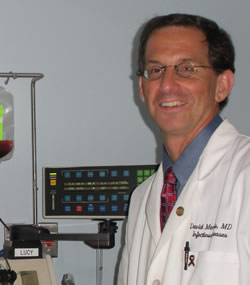In Search of a Cure: Working to Turn On HIV
Rowena Johnston, Ph.D., and Jeffrey Laurence, M.D.
October 16, 2009—Much of the research aimed at developing new therapeutic strategies for HIV deals with finding ways to limit the ability of the virus to make copies of itself. But in some situations, turning on the virus—activating its growth from silent or latent reservoirs resistant to antiretroviral drug attack—may be just as important, particularly in the search for strategies to eradicate the last vestiges of HIV. Two amfAR-funded scientists, Dr. David Margolis of the University of North Carolina at Chapel Hill and Dr. Miranda Shehu-Xhilaga of Monash University in Melbourne, Australia, addressed this concept in separate articles published this September in two issues of AIDS.

Dr. Miranda Shehu-Xhilaga |
As paradoxical as it might seem, dialing up the growth of the virus may be a valid strategy in HIV-infected individuals who have been successfully treated with antiretroviral drugs. While they have little to no virus in their blood that can be detected using standard tests, they have a relatively small number of T cells infected with latent virus—approximately a million. This latent HIV has entered a state of dormancy, beyond the reach of the immune system or standard anti-HIV drugs. Because these cells will remain infected for the life of the patient, with the potential to touch off multiple new rounds of virus replication at any moment, scientists are investigating approaches to destroy this perpetual source of new virus growth.
One means by which HIV maintains its latent state is by carrying high levels of cellular proteins known as histone deacetylases (HDACs), whose normal role in a cell is to act as a switch that turns off the ability to make other proteins. In the context of HIV, HDACs attached to stretches of the virus turn off its ability to make copies of itself, rendering the virus latent. Several years ago Dr. Margolis, working with amfAR funding, showed in the test tube that certain cancer drugs that inhibit the HDACs undo the latency of HIV and thus render the virus susceptible to attack by standard anti-HIV drugs. But pilot trials of one such drug in patients revealed the need to fine tune this approach.
In separate studies, Drs. Margolis and Shehu-Xhilaga now report on some novel HDAC inhibitors with more potent HIV-activating capability. Dr. Margolis utilized a new technology called high-throughput screening to evaluate a series of potential drugs that act against one or both of two major classes of HDAC. He found that the drugs active against class I were “strikingly efficient” promoters of HIV growth in test tube models of latent HIV infection, as well as in T cells obtained directly from patients with undetectable viral loads. These class I HDAC inhibitors had these effects without disturbing the ability of the cells themselves to grow.

Dr. David Margolis |
Dr. Shehu-Xhilaga also found that class I HDAC inhibitors were effective HIV inducers, and with her team synthesized two novel drug candidates, MCT-1 and MCT-3, based on a known anti-cancer drug, oxamflatin. Like Dr. Margolis’s compounds, these three agents were strikingly powerful in promoting virus outgrowth. Dr. Shehu-Xhilaga cautioned, however, that the toxicity of her compounds “may limit their use in patients.” Details remain to be resolved, but these two studies continue to point the way to the development of potential agents that may be clinically useful in novel strategies for HIV treatment.